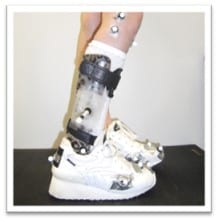EXCLUSIVE: The effect of changes to AFOs when walking in children with cerebral palsy

Staffordshire University’s Nicola Eddison, Aoife Healy, and Nachiappan Chockalingam discuss their findings from the past decade about how gait is affected by changes to the design of ankle-foot orthoses and whether these changes affect the amount of energy used by the child when walking.
Cerebral palsy (CP) has been identified as the most common physically disabling condition(1), with no two people being affected in the same way. Overall global rates of CP are between two and three per 1,000 live births(2), and studies from several countries have reported increased prevalence over time(3–6).
With as much as 50-80 percent of individuals with CP achieving the ability to walk in some manner(7,8) our research over the past 10 years focused on ankle-foot orthoses (AFOs) worn by children with CP, and how gait is affected by changes to the design of the AFO and whether these changes affect the amount of energy used by the child when walking.
Initially, we looked at how orthotists in the UK prescribe AFOs and what adaptations they make to improve the patient’s ability to walk, and what barriers might be preventing them from carrying out further optimisation(9). Although orthotists reported a lack of access to 3D gait analysis and a lack of time required to make all the necessary changes required, we also found that there was some misunderstanding amongst orthotists regarding the changes that can be made without expensive technology.
Following on from this study we investigated the current reporting methods of researchers when studying AFOs and concluded that none of the papers reviewed adequately described the design and material of the AFO being studied(10), the potential impact of this, is that clinicians can’t use the research to make clinical decisions for their patients, or worse, they wrongly interpret the research which may negatively impact their clinical practice.
We now had an understanding of how orthotists were prescribing AFOs in the UK, and the reporting methods of researchers studying AFOs. The next step was to get a group of CP children in our gait lab to observe the way they walk and how much energy they used when walking without AFOs and with
AFOs that had been optimised (see figure 1) to improve their gait as much as possible, compared to AFOs with no optimisation(11,12).
The results showed that the AFOs that had been specially optimised had the potential to improve the child’s gait, in particular their hip and pelvis movements and certain knee movements (see figure 2), which were closer to normal when the AFO was optimised. Furthermore, the child’s energy expenditure decreased whilst the speed and distance covered increased.
We concluded from this that all children wearing AFOs should have them optimised to get the best results possible, allowing them to achieve their best possible gait pattern.
Future research
We are currently working on standardising the terminology we use as clinicians and researchers when discussing AFOs to enable improve communication and the ability to draw conclusions from research and inform clinical practice.

References
- Stanley F. Cerebral Palsies: epidemology and causal pathways. Hilary H, editor. London, United Kingdom: Mac Keith Press; 2000.
- Ozmen M, Caliskan M AS and GG. 8-year clinical experience in cerebral palsy. J Trop Pediatr. 1993;39:52–4.
- Liu J.M, Li S LQ and LZ. Prevalence of cerebral palsy in China. Int J Epidemiol. 1999;28(5):949–54.
- Wichers MJ, van der Schouw YT, Moons KG, Stam HJ, van Nieuwenhuizen O. Prevalence of cerebral palsy in The Netherlands (1977-1988). Eur J Epidemiol. 2001;17(6):527–32.
- Winter S, Autry A, Boyle C, Yeargin-Allsopp M. Trends in the prevalence of cerebral palsy in a population-based study. Pediatrics. 2002 Dec;110(6):1220–5.
- Cans C GP and AC. Prevalence and characteristics of children with cerebral palsy in Europe. Dev Med Child Neurol [Internet]. 2002 Sep;44(9):633–40. Available from: h
-
Figure 2: A graph showing the position of the knee during walking note the optimised (Tuned) condition compared to non-optimised (Non-Tuned). Gage JR. The identification and treatment of gait problems in cerebral palsy. Mac Keith Press; 2009. 644 p.
- Armand S, Decoulon G, Bonnefoy-Mazure A. Gait analysis in children with cerebral palsy. EFORT Open Rev [Internet]. 2016;1(12):448–60. Available from: http://www.efortopenreviews.org/lookup/doi/10.1302/2058-5241.1.000052
- Eddison N, Chockalingam N. Ankle foot orthosis−footwear combination tuning: An investigation into common clinical practice in the United Kingdom. Prosthet Orthot Int. 2014;1–2.
- Eddison N, Mulholland M, Chockalingam N. Do research papers provide enough information on design and material used in ankle foot orthoses for children with cerebral palsy? A systematic review. J Child Orthop [Internet]. 2017 Jul 3 [cited 2017 Jul 4];1–9. Available from: http://online.boneandjoint.org.uk/doi/10.1302/1863-2548.11.160256
- Eddison N, Healy A, Needham R, Chockalingam N. The effect of tuning ankle foot orthoses-footwear combinations on gait kinematics of children with cerebral palsy: a case series. Foot [Internet]. 2019;43(December 2019):101660. Available from: https://doi.org/10.1016/j.foot.2019.101660
- Eddison N; Chockalingam N; Healy A; Needham R; Unnithan V. Exploratory Investigation into Energy Expenditure Using Tuned versus Nontuned Ankle-Foot Orthoses–Footwear Combinations in Children with Cerebral Palsy. J Prosthetics Orthot. 2019;




